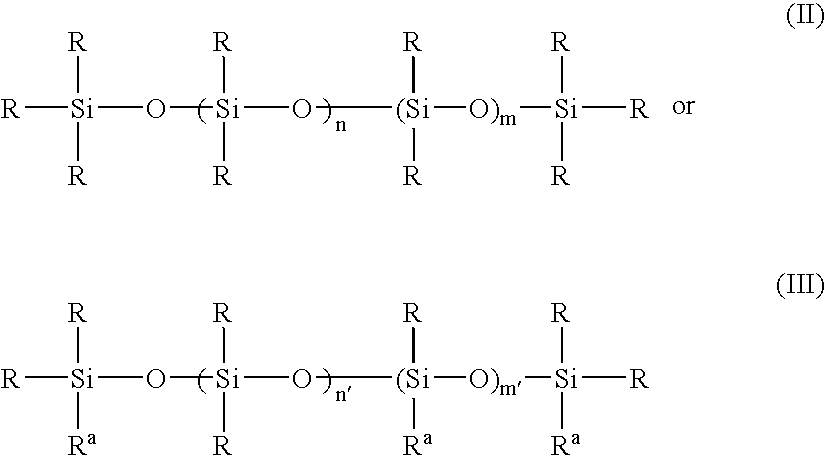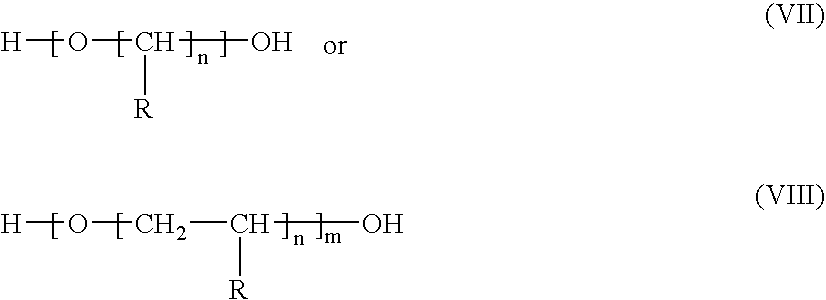Multi-layer composites formed from compositions having improved adhesion, coating compositions, and methods related thereto
a composite and composition technology, applied in the field of multi-layer composites, can solve the problems of poor interlayer adhesion, paint defects in the application or curing of the basecoat or the clearcoat, and the defect of the topcoat coating composition, so as to improve the interlayer adhesion of the first polymeric layer and poor interlayer adhesion
- Summary
- Abstract
- Description
- Claims
- Application Information
AI Technical Summary
Benefits of technology
Problems solved by technology
Method used
Image
Examples
examples
Example AA describes the preparation of a polysiloxane polyol. Examples BB and CC describe the preparation of a carbamate functional acrylic resin and a carbamate functional polyester resin, respectively. Examples A through J describe the preparation of various adhesion promoters used in the compositions of the present invention. Coating composition Examples 1 through 9 describe the preparation of one-component clearcoating compositions. Examples 10 through 13 describe the preparation of clearcoating compositions based on epoxy-containing acrylic resins in conjunction with acid functional curing agents. Examples 14 through 23 describe the preparation of two-component clearcoating compositions. Examples 24 and 25 describe the preparation of basecoating compositions. Examples 26 through 30 describe the preparation of clearcoating compositions based on carbamate group-containing resins, and Examples 31 through 33 describe the preparation of powder clearcoating compositions.
example aa
Resin Compositions Example AA
Polysiloxane Polyol
This example describes the preparation of a polysiloxane polyol which was subsequently used to form respective silica dispersions of Examples A and B, and the adhesion promoters used in the thermosetting compositions of the present invention. The polysiloxane polyol was a product of the hydrosilylation of a reactive silicone fluid having an approximate degree of polymerization of 3 to 7, i.e., (Si—O)3 to (Si—O)7. The polysiloxane polyol was prepared from a proportionately scaled-up batch of the following mixture of ingredients in the ratios indicated:
EquivalentParts By WeightIngredientsWeightEquivalents(kilograms)Charge I:Trimethylolpropane174.0756.0131.54monoallyl etherCharge II:MASILWAX BASE1 156.72594.893.21Charge III:Chloroplatinic acid10 ppmToluene0.23Isopropanol0.07
1Polysiloxane-containing silicon hydride, commercially available from BASF Corporation.
2Equivalent weight based on mercuric bichloride determination.
To a suitab...
example bb
Carbamate Functionalacrylic Polymer
This example describes the preparation of a carbamate functional acrylic used in the clearcoating compositions of Examples 26-30 described below. The polymer was prepared from the following ingredients:
IngredientWeight in PartsAcrylic polymer11614.4Methyl carbamate240.3Butyl stannoic acid3.05Triphenyl phosphite3.05
1Prepared from hydroxypropyl acrylate, butyl methacrylate and alpha methyl styrene dimer, 90% solids in DOWANOL ® PM.
A suitable reactor equipped with a thermocouple, overhead stirrer, nitrogen inlet and a reflux condenser was charged with the above ingredients. The reaction mixture was heated to a temperature of 145° C. under a nitrogen blanket. At this temperature, reflux was observed. The reaction mixture was held at reflux for one hour. After the hold period was complete, the reflux condenser was removed, and the reactor equipped for distillation (short column, still head, thermocouple, and receiver) at atmospheric pressure. Dist...
PUM
| Property | Measurement | Unit |
|---|---|---|
| adhesion | aaaaa | aaaaa |
| concentration | aaaaa | aaaaa |
| mole percent | aaaaa | aaaaa |
Abstract
Description
Claims
Application Information
 Login to View More
Login to View More - R&D
- Intellectual Property
- Life Sciences
- Materials
- Tech Scout
- Unparalleled Data Quality
- Higher Quality Content
- 60% Fewer Hallucinations
Browse by: Latest US Patents, China's latest patents, Technical Efficacy Thesaurus, Application Domain, Technology Topic, Popular Technical Reports.
© 2025 PatSnap. All rights reserved.Legal|Privacy policy|Modern Slavery Act Transparency Statement|Sitemap|About US| Contact US: help@patsnap.com



